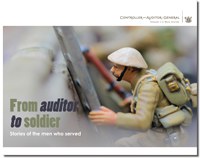The Audit Department
At the outbreak of WW1, the Audit Department was located in the Government Buildings in Lambton Quay, Wellington and had a staff of 61, headed by the Auditor-General. The next most senior person was the Chief Clerk, who was also the Deputy Auditor-General.
Published lists of staff employed at the Audit Department shows staff ranked in order of seniority. The Chief Clerk was graded as “Class I”. There was a “Clerk in Charge Control Assets”, Class II. There were 14 Audit Inspectors, based at offices around New Zealand. Audit Inspectors ranged from Class II to Class V.
Most of the remaining staff were appointed as Examiners, ranging from Class V to class VII. Two staff were classified as Book Keepers. There were subdivisions within each class.
On average, Audit Inspectors were paid £426 a year. Examiners were, on average, paid £261 a year.
To be appointed to the Audit Department, or to any other civil service position, applicants had to first pass the Junior Civil Service Examination. This was not an easy examination and in some years only a quarter of those who sat the examination passed.
The names of the successful candidates were published in newspapers, ranked from the person who obtained the highest pass mark to the person who obtained the lowest pass mark.
A pass did not automatically mean appointment to a civil service position, because there were few vacancies. Once appointed to a civil service position, further advancement depended on passing the Senior Civil Service Examination.
If appointed to the Audit Department, staff were expected to have “experience in ledger keeping”. In 1914, only one staff member is listed as having an accounting qualification.
The Audit Department was adopting new technology. In 1914, the Public Service Commissioner surveyed the extent to which departments were adopting “modern methods” and found that the Audit Department was one of the few that had used any mechanical aids before 1913; two adding machines and one “computing machine”.
Turning auditors into soldiers
Despite the clerical nature of their work, Audit Department staff would have had some exposure to the skills required of soldiers. The Defence Act of 1909 had set up a system of compulsory military training.
Boys between the ages of 12 and 14 had to undergo 52 hours of physical training each year as “Junior Cadets”. From the age of 14 to 18, young men were required to serve in the Cadet Corps. Those aged between 18 and 25 had to serve in the Territorial Force, completing 12 half-day parades and 7 days in camp each year.
After the age of 25, they were placed on the reserve list, until age 30. There was provision for discharge at age 30, but men could still be called up for military service until the age of 55.
After enlisting, men were sent to military camps. They were trained at either the Trentham Military Camp (north of Wellington) or the Featherston Military Camp (in the Wairarapa).
Poor living conditions at Trentham led to an outbreak of respiratory illness in mid-1915 that killed 27 soldiers. The Trentham Camp was closed for a time and had to be rebuilt. It could accommodate up to 7000 soldiers.
The training camp at Featherston had to be expanded and became the main camp for training soldiers. It could accommodate almost 10,000 soldiers. About two-thirds of the men sent overseas were trained there. During four months, soldiers learned to march, dig trenches, and fire rifles, machine guns, and artillery.
Most men trained as infantry but others trained as stretcher bearers, signallers, engineers, gunners, cooks, and clerks. After training, the soldiers were marched over the Rimutaka Hill road to Trentham Camp, before leaving on ships for Europe. Featherston people would travel to the summit of the hill road and offer tea and food to the soldiers when they reached the summit.
When the New Zealand troops arrived overseas, they were put through more advanced training, initially carried out in Egypt and in the United Kingdom from April 1916. This training concentrated on improving the ability of soldiers to fight together as an effective unit.

